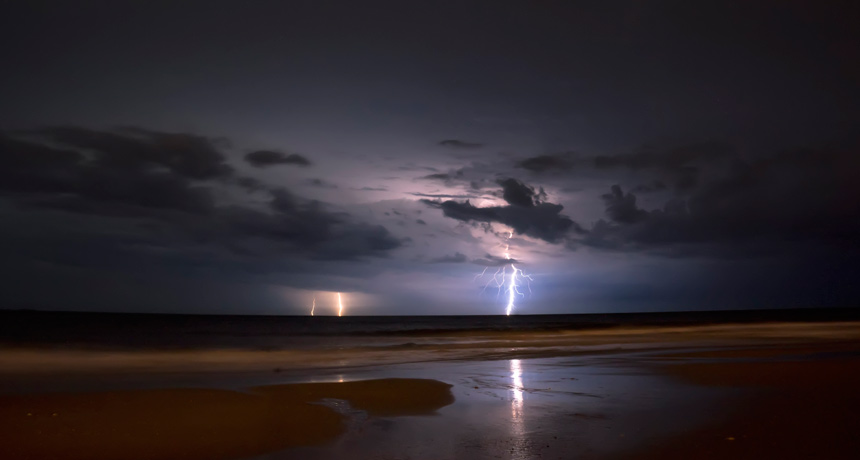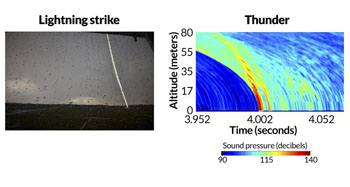Scientists ‘see’ thunder for first time
Map of sound waves sheds light on the energy behind lightning

A flash of lightning is accompanied by loud cracks of thunder. Now scientists have mapped how that sound develops.
JAMES LOESCH/FLICKR (CC BY 2.0)
MONTREAL, Canada — With thunder, there’s always lots to hear. Now there’s also something to see. For the first time, scientists have precisely mapped the loud clap radiating from a lightning strike. This picture of thunder’s origins could reveal the energies involved in powering some of nature’s flashiest light shows.
SEEING THUNDER Scientists shot a long copper wire into a cloud using a small rocket. This generated a bolt of lightning. The current followed the wire to the ground. This allowed researchers to record the sound waves of the resulting thunder. The intense heating of the copper wire caused the green flashes. Univ. of Florida, Florida Institute of Technology, SRI |
Lightning strikes when an electric current flows from a negatively charged cloud to the ground. This rapidly heats and expands the surrounding air, creating sonic shock waves. We hear this as thunder.
Scientists have a basic understanding of the origins of thunder. Still, experts have lacked a detailed picture of the physics powering the loud cracks and low rumbles.
Maher Dayeh works at the Southwest Research Institute in San Antonio, Texas. As a heliophysicist, he studies the sun and its effects on the solar system, including Earth. He and his colleagues also study lightning — by making their own. These experts trigger the bolts by firing a small rocket into an electrically charged cloud. Trailing behind the rocket is a long, Kevlar-coated copper wire. The lightning travels along that wire to the ground.
For their new experiment, the scientists used 15 sensitive microphones laid out 95 meters (312 feet) from the strike zone. The team then precisely recorded the incoming sound waves. Those from higher elevations took longer to reach the microphones. That allowed the scientists to map the

How loud a thunderclap sounds will depend on the peak electric current flowing through the lightning, the researchers found. Explains Dayeh, this discovery could one day allow scientists to use thunder to sound out the amount of energy powering a lightning strike.
Power Words
(for more about Power Words, click here)
acoustics The science related to sounds and hearing.
conductive Able to carry an electric current.
decibel A measurement scale used for the intensity of sounds that can be picked up by the human ear. It starts at zero decibels (dB), a sound hardly audible to people with good hearing. A sound 10 times louder would be 10 dB. Because the scale is logarithmic, a sound 100 times louder than 0 dB would be 20 dB; one that’s 1,000 times louder than 0 dB would be described as 30 dB.
electric charge The physical property responsible for electric force; it can be negative or positive.
electric current A flow of charge, called electricity, usually from the movement of negatively charged particles, called electrons.
Kevlar A super-strong plastic fiber developed by DuPont in the 1960s and initially sold in the early 1970s. It’s stronger than steel, but weighs much less, and won’t melt.
lightning A flash of light triggered by the discharge of electricity that occurs between clouds or between a cloud and something on Earth’s surface. The electrical current can cause a flash heating of the air, which can create a sharp crack of thunder.
physics The scientific study of the nature and properties of matter and energy. Classical physics is an explanation of the nature and properties of matter and energy that relies on descriptions such as Newton’s laws of motion. It’s an alternative to quantum physics in explaining the motions and behavior of matter. A scientist who works in that field is known as a physicist.
radiate (in physics) To emit energy in the form of waves.
rocket Something propelled into the air or through space, usually by the release of exhaust gases as some fuel burns. Or something that flings into space at high speed as if fueled by combustion.
sonic Of or relating to sound.







